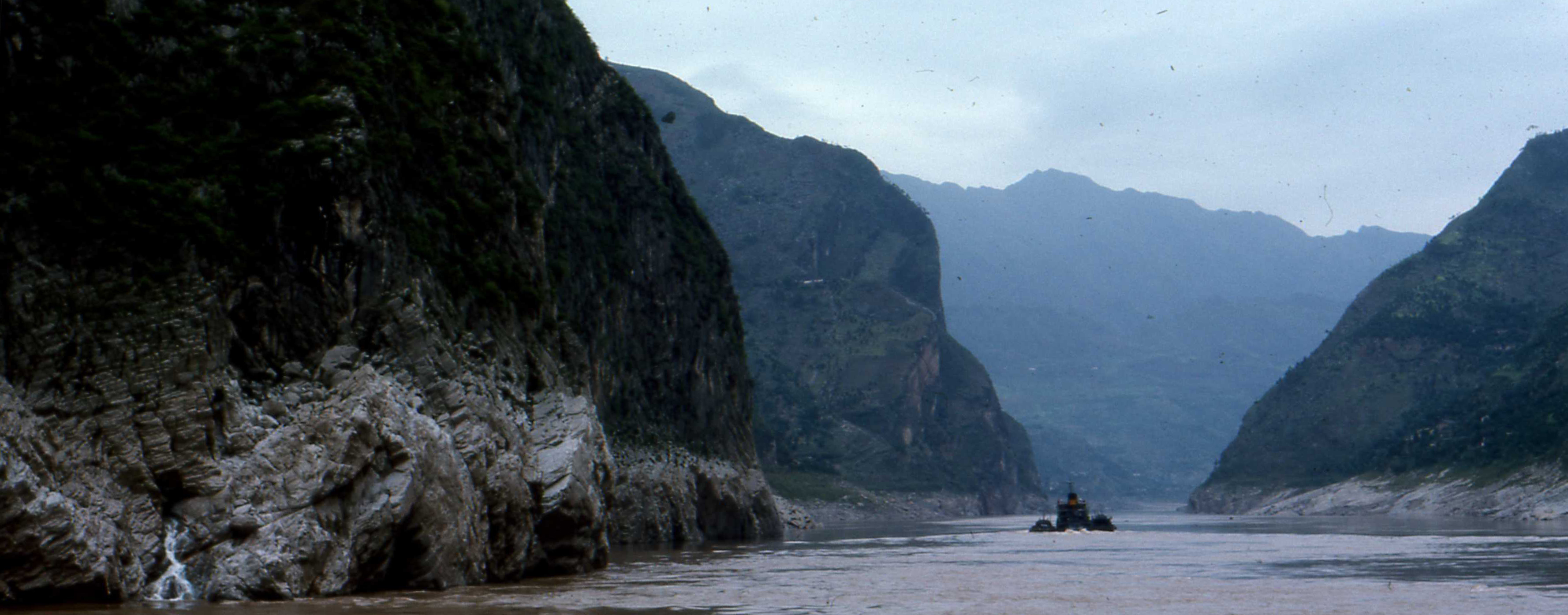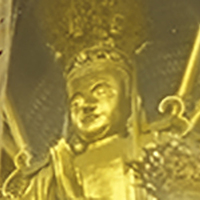-
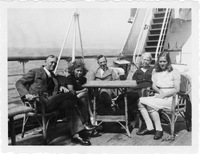 Graham Family on SS Jean LaBorde, 1939
Graham Family on SS Jean LaBorde, 1939 The Graham family sitting around a wicker table on the deck of the French ocean liner, SS Jean LaBorde. Left to right: David, Dorothy, unidentified man, Alicia, Jean.
-
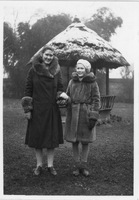 Graham Daughters with Snow-Covered Pavilion
Graham Daughters with Snow-Covered Pavilion Dorothy (left) and Jean (right) Graham pose in fur-trimmed coats in front of a Chinese pavilion with snow on its thatched roof. The ground is covered with grass, so the snow must not have been much.
-
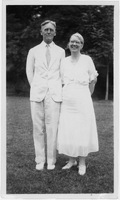 Graham Wedding Anniversary
Graham Wedding Anniversary David and Alicia are standing in their garden at WCUU wearing white clothes and smiling. There are trees in the background.
-
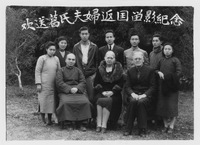 Graham's Farewell Reception, 1948
Graham's Farewell Reception, 1948 Alicia and David Graham are seated on chairs on their lawn on the WCUU campus with eight unidentified Chinese men and women. The Chinese women and one of the men wear padded qipaos. The other Chinese men wear Western-style clothes of various kinds. Alicia wears a fur trimmed coat. There is a Chinese inscription written along the top that refers to the occasion of the Grahams leaving China for good.
-
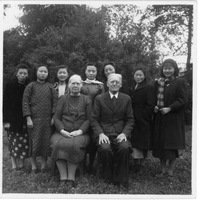 Grahams with Seven Foster Daughters
Grahams with Seven Foster Daughters Alicia and David Graham are seated on chairs on their lawn on the WCUU campus. There are seven Chinese women standing in a row behind them. Everyone wears coats, sweaters or scarves, so it must be a chilly day. There are trees in the background.
-
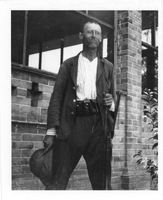 David Crockett Graham Home from Tatsienlu
David Crockett Graham Home from Tatsienlu David Crockett Graham in his expedition gear, which includes a striped undershirt, cardigan, trousers, belt with gear attached, walking stick and pith helmet. His face is unshaven. He stands before a brick building with a window.
-
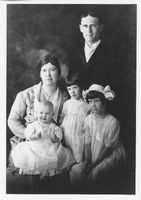 Graham Family Portrait, 1919
Graham Family Portrait, 1919 Formal portrait of David and Alicia Graham with their three children, Margaret (center), Dorothy (lower right), and Harriet (on Alicia's lap). Mom and girls wear white dresses.
-
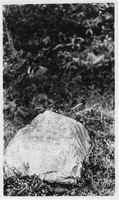 David Crockett Graham Jr's Gravestone
David Crockett Graham Jr's Gravestone A stone engraved with "David Crockett Graham Jr, Feb. 14 - Dec. 17, 1914" sits on a bed of ferns with foliage in the background.
-
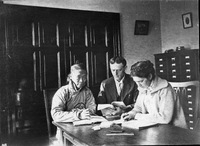 David and Alicia Graham Studying Chinese Language
David and Alicia Graham Studying Chinese Language David and Alicia are reading Chinese language textbooks, while their Chinese instructor also has a book open in front of him, but he looks at the camera. He is wearing a silk embroidered gown with a scholar's cap. The group are seated at a wooden table and there is a wooden screen and filing cabinet in the room behind them.
-
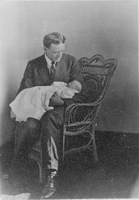 David Crockett Graham with Baby Margaret
David Crockett Graham with Baby Margaret David holds a day old Margaret, the Grahams' first of five daughters. He is seated on a wicker chair.
-
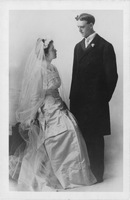 Graham Wedding Portrait
Graham Wedding Portrait Formal portrait of David and Alicia Graham on their wedding day. David wears a long jacket with white tie and turned up collar. He has a small flower in his lapel. Alicia wears a floor length white satin dress with a lace bodice. She wears a floor length veil and glasses, making her look very scholarly, as she was.
-
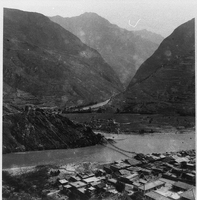 City of Weichou Looking Down From a Hill
City of Weichou Looking Down From a Hill The roofs of a cityscape are in the foreground. Behind it can be seen the confluence of the Min and Zagulao Rivers, with the bamboo suspension bridge seen over the Min. In the background are mountain ranges.
-
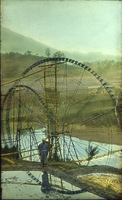 Bamboo Waterwheel Used to Raise Water for Irrigation
Bamboo Waterwheel Used to Raise Water for Irrigation A Chinese man stands posing in front of a huge waterwheel used to move water into terraced fields. Another waterwheel can be seen to the left behind him. The entire Chengdu Plain was provided with water by the Dujiangyan waterworks, using such waterwheels, large and small, to push the water into the fields.
-
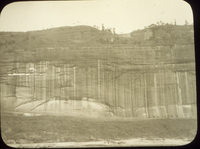 The Ribbon Counter Cliff on the Min River
The Ribbon Counter Cliff on the Min River Probably taken from a boat as Graham was passing by on his way from Yibin to Leshan, the photo depicts a cliff on the shoreline that features vertical stripes. The photo is in black and white, but Graham describes these stripes as "multi-colored." Two people on the shoreline provide a perspective of how massive this rock face is.
-
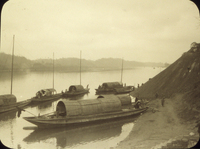 Chinese Wooden Boats on the Min River
Chinese Wooden Boats on the Min River A group of small wooden boats of the kind common on the Min River between Chengdu and Yibin. The boats are covered with woven bamboo mats through the middle. Most of them have masts for sailing when weather permits. They are sheltering at a sandy beach.
-
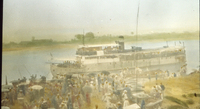 Steamboat Assisting Refugees to Cross the Min River
Steamboat Assisting Refugees to Cross the Min River Taken from the shoreline, this image shows a steamboat crowded with people whom Graham explains are soldiers in a retreating army that has commandeered their steamer to cross the river, a process that took two days.
-
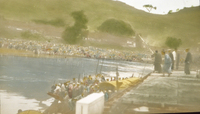 Refugees Trying to Cross the Min River
Refugees Trying to Cross the Min River Taken from the top of the steamboat that Graham was on. A crowded Chinese wooden boat is below alongside them. On the shoreline across the river there is a huge crowd of refugees, which Graham explains are in a retreating army.
-
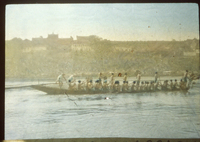 Chinese Dragon Boat at the Annual Dragon Boat Festival
Chinese Dragon Boat at the Annual Dragon Boat Festival A long narrow boat with many men in it rowing and poling. It looks like they are racing. Graham's caption draws attention to a dragon's head, but it is not clearly visible in the image. There are large Chinese-style buildings on the shoreline in the background.
-
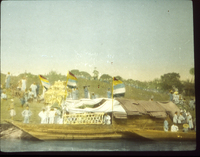 Festival Boat at Tuan-yang Festival, Suifu
Festival Boat at Tuan-yang Festival, Suifu Small wooden boat decorated with a large golden dragon or lion head and three "Five Races Under One Union" flags of the Republic of China. This latter means that this image was taken before 1928 when the Guomindang gained control over all China and used their own flag. A crowd is gathered on the shore to watch.
-
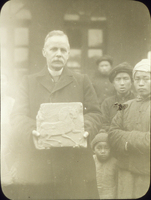 Rev. Thomas Torrance with a Han Dynasty Brick
Rev. Thomas Torrance with a Han Dynasty Brick Thomas Torrance stands outdoors holding a sandstone brick with a relief of a prancing horse on it. The brick is about a foot square. There are a small group of Chinese looking on, including one small child.
-
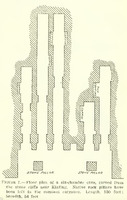 Diagram of Interior of Cave Tombs
Diagram of Interior of Cave Tombs Diagram of a six chamber cave tomb, showing the two pillars in the entranceway and the coffin alcoves within the chambers. The chambers are of different lengths, from two very deep ones to one very shallow one.
-
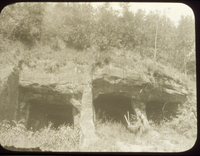 Cave Tomb Entrance with Chinese Man
Cave Tomb Entrance with Chinese Man Three square-shaped cave entrances are in a row. A Chinese man walks away from them with a pair of large baskets. The entrances appear to be about twice the height of the man, and just as wide. A forest of trees grows above the caves.
-
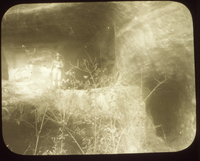 Cave Tomb Entrance with Missionary
Cave Tomb Entrance with Missionary Three cave entrances are clearly visible. Their large scale is apparent by the unidentified missionary that stands on the top level of entrances. There is an alcove next to the missionary that might have a carved relief in it.
-
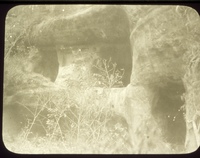 Opening to Multilevel Cave Tomb
Opening to Multilevel Cave Tomb The entrance to cave tombs on three distinct levels. On the right is a tall entranceway between the height of two levels of entrances to the left. There appear to be four entrances, but the lower ones are obscured by foliage. There is an alcove between the two entrances at the top level that might have a carved relief in it.
-
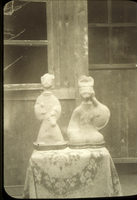 Clay Human Figures from Cave Tomb
Clay Human Figures from Cave Tomb Two clay statues, a man (left) and a woman (right), stand upon a small lace-covered table. From the size of the window behind them, they appear to be about a foot tall. The man stands with unidentified implements in both hands. He wears a floor-length gown. He has either long coiffed hair or wears a hat. He appears to be smiling. The woman is seated in a kneeling position with her left hand held up to her face. She wears the same type of robe as the man with a turban style hat.
 Graham Family on SS Jean LaBorde, 1939 The Graham family sitting around a wicker table on the deck of the French ocean liner, SS Jean LaBorde. Left to right: David, Dorothy, unidentified man, Alicia, Jean.
Graham Family on SS Jean LaBorde, 1939 The Graham family sitting around a wicker table on the deck of the French ocean liner, SS Jean LaBorde. Left to right: David, Dorothy, unidentified man, Alicia, Jean. Graham Daughters with Snow-Covered Pavilion Dorothy (left) and Jean (right) Graham pose in fur-trimmed coats in front of a Chinese pavilion with snow on its thatched roof. The ground is covered with grass, so the snow must not have been much.
Graham Daughters with Snow-Covered Pavilion Dorothy (left) and Jean (right) Graham pose in fur-trimmed coats in front of a Chinese pavilion with snow on its thatched roof. The ground is covered with grass, so the snow must not have been much. Graham Wedding Anniversary David and Alicia are standing in their garden at WCUU wearing white clothes and smiling. There are trees in the background.
Graham Wedding Anniversary David and Alicia are standing in their garden at WCUU wearing white clothes and smiling. There are trees in the background. Graham's Farewell Reception, 1948 Alicia and David Graham are seated on chairs on their lawn on the WCUU campus with eight unidentified Chinese men and women. The Chinese women and one of the men wear padded qipaos. The other Chinese men wear Western-style clothes of various kinds. Alicia wears a fur trimmed coat. There is a Chinese inscription written along the top that refers to the occasion of the Grahams leaving China for good.
Graham's Farewell Reception, 1948 Alicia and David Graham are seated on chairs on their lawn on the WCUU campus with eight unidentified Chinese men and women. The Chinese women and one of the men wear padded qipaos. The other Chinese men wear Western-style clothes of various kinds. Alicia wears a fur trimmed coat. There is a Chinese inscription written along the top that refers to the occasion of the Grahams leaving China for good. Grahams with Seven Foster Daughters Alicia and David Graham are seated on chairs on their lawn on the WCUU campus. There are seven Chinese women standing in a row behind them. Everyone wears coats, sweaters or scarves, so it must be a chilly day. There are trees in the background.
Grahams with Seven Foster Daughters Alicia and David Graham are seated on chairs on their lawn on the WCUU campus. There are seven Chinese women standing in a row behind them. Everyone wears coats, sweaters or scarves, so it must be a chilly day. There are trees in the background. David Crockett Graham Home from Tatsienlu David Crockett Graham in his expedition gear, which includes a striped undershirt, cardigan, trousers, belt with gear attached, walking stick and pith helmet. His face is unshaven. He stands before a brick building with a window.
David Crockett Graham Home from Tatsienlu David Crockett Graham in his expedition gear, which includes a striped undershirt, cardigan, trousers, belt with gear attached, walking stick and pith helmet. His face is unshaven. He stands before a brick building with a window. Graham Family Portrait, 1919 Formal portrait of David and Alicia Graham with their three children, Margaret (center), Dorothy (lower right), and Harriet (on Alicia's lap). Mom and girls wear white dresses.
Graham Family Portrait, 1919 Formal portrait of David and Alicia Graham with their three children, Margaret (center), Dorothy (lower right), and Harriet (on Alicia's lap). Mom and girls wear white dresses. David Crockett Graham Jr's Gravestone A stone engraved with "David Crockett Graham Jr, Feb. 14 - Dec. 17, 1914" sits on a bed of ferns with foliage in the background.
David Crockett Graham Jr's Gravestone A stone engraved with "David Crockett Graham Jr, Feb. 14 - Dec. 17, 1914" sits on a bed of ferns with foliage in the background. David and Alicia Graham Studying Chinese Language David and Alicia are reading Chinese language textbooks, while their Chinese instructor also has a book open in front of him, but he looks at the camera. He is wearing a silk embroidered gown with a scholar's cap. The group are seated at a wooden table and there is a wooden screen and filing cabinet in the room behind them.
David and Alicia Graham Studying Chinese Language David and Alicia are reading Chinese language textbooks, while their Chinese instructor also has a book open in front of him, but he looks at the camera. He is wearing a silk embroidered gown with a scholar's cap. The group are seated at a wooden table and there is a wooden screen and filing cabinet in the room behind them. David Crockett Graham with Baby Margaret David holds a day old Margaret, the Grahams' first of five daughters. He is seated on a wicker chair.
David Crockett Graham with Baby Margaret David holds a day old Margaret, the Grahams' first of five daughters. He is seated on a wicker chair. Graham Wedding Portrait Formal portrait of David and Alicia Graham on their wedding day. David wears a long jacket with white tie and turned up collar. He has a small flower in his lapel. Alicia wears a floor length white satin dress with a lace bodice. She wears a floor length veil and glasses, making her look very scholarly, as she was.
Graham Wedding Portrait Formal portrait of David and Alicia Graham on their wedding day. David wears a long jacket with white tie and turned up collar. He has a small flower in his lapel. Alicia wears a floor length white satin dress with a lace bodice. She wears a floor length veil and glasses, making her look very scholarly, as she was. City of Weichou Looking Down From a Hill The roofs of a cityscape are in the foreground. Behind it can be seen the confluence of the Min and Zagulao Rivers, with the bamboo suspension bridge seen over the Min. In the background are mountain ranges.
City of Weichou Looking Down From a Hill The roofs of a cityscape are in the foreground. Behind it can be seen the confluence of the Min and Zagulao Rivers, with the bamboo suspension bridge seen over the Min. In the background are mountain ranges. Bamboo Waterwheel Used to Raise Water for Irrigation A Chinese man stands posing in front of a huge waterwheel used to move water into terraced fields. Another waterwheel can be seen to the left behind him. The entire Chengdu Plain was provided with water by the Dujiangyan waterworks, using such waterwheels, large and small, to push the water into the fields.
Bamboo Waterwheel Used to Raise Water for Irrigation A Chinese man stands posing in front of a huge waterwheel used to move water into terraced fields. Another waterwheel can be seen to the left behind him. The entire Chengdu Plain was provided with water by the Dujiangyan waterworks, using such waterwheels, large and small, to push the water into the fields. The Ribbon Counter Cliff on the Min River Probably taken from a boat as Graham was passing by on his way from Yibin to Leshan, the photo depicts a cliff on the shoreline that features vertical stripes. The photo is in black and white, but Graham describes these stripes as "multi-colored." Two people on the shoreline provide a perspective of how massive this rock face is.
The Ribbon Counter Cliff on the Min River Probably taken from a boat as Graham was passing by on his way from Yibin to Leshan, the photo depicts a cliff on the shoreline that features vertical stripes. The photo is in black and white, but Graham describes these stripes as "multi-colored." Two people on the shoreline provide a perspective of how massive this rock face is. Chinese Wooden Boats on the Min River A group of small wooden boats of the kind common on the Min River between Chengdu and Yibin. The boats are covered with woven bamboo mats through the middle. Most of them have masts for sailing when weather permits. They are sheltering at a sandy beach.
Chinese Wooden Boats on the Min River A group of small wooden boats of the kind common on the Min River between Chengdu and Yibin. The boats are covered with woven bamboo mats through the middle. Most of them have masts for sailing when weather permits. They are sheltering at a sandy beach. Steamboat Assisting Refugees to Cross the Min River Taken from the shoreline, this image shows a steamboat crowded with people whom Graham explains are soldiers in a retreating army that has commandeered their steamer to cross the river, a process that took two days.
Steamboat Assisting Refugees to Cross the Min River Taken from the shoreline, this image shows a steamboat crowded with people whom Graham explains are soldiers in a retreating army that has commandeered their steamer to cross the river, a process that took two days. Refugees Trying to Cross the Min River Taken from the top of the steamboat that Graham was on. A crowded Chinese wooden boat is below alongside them. On the shoreline across the river there is a huge crowd of refugees, which Graham explains are in a retreating army.
Refugees Trying to Cross the Min River Taken from the top of the steamboat that Graham was on. A crowded Chinese wooden boat is below alongside them. On the shoreline across the river there is a huge crowd of refugees, which Graham explains are in a retreating army. Chinese Dragon Boat at the Annual Dragon Boat Festival A long narrow boat with many men in it rowing and poling. It looks like they are racing. Graham's caption draws attention to a dragon's head, but it is not clearly visible in the image. There are large Chinese-style buildings on the shoreline in the background.
Chinese Dragon Boat at the Annual Dragon Boat Festival A long narrow boat with many men in it rowing and poling. It looks like they are racing. Graham's caption draws attention to a dragon's head, but it is not clearly visible in the image. There are large Chinese-style buildings on the shoreline in the background. Festival Boat at Tuan-yang Festival, Suifu Small wooden boat decorated with a large golden dragon or lion head and three "Five Races Under One Union" flags of the Republic of China. This latter means that this image was taken before 1928 when the Guomindang gained control over all China and used their own flag. A crowd is gathered on the shore to watch.
Festival Boat at Tuan-yang Festival, Suifu Small wooden boat decorated with a large golden dragon or lion head and three "Five Races Under One Union" flags of the Republic of China. This latter means that this image was taken before 1928 when the Guomindang gained control over all China and used their own flag. A crowd is gathered on the shore to watch. Rev. Thomas Torrance with a Han Dynasty Brick Thomas Torrance stands outdoors holding a sandstone brick with a relief of a prancing horse on it. The brick is about a foot square. There are a small group of Chinese looking on, including one small child.
Rev. Thomas Torrance with a Han Dynasty Brick Thomas Torrance stands outdoors holding a sandstone brick with a relief of a prancing horse on it. The brick is about a foot square. There are a small group of Chinese looking on, including one small child. Diagram of Interior of Cave Tombs Diagram of a six chamber cave tomb, showing the two pillars in the entranceway and the coffin alcoves within the chambers. The chambers are of different lengths, from two very deep ones to one very shallow one.
Diagram of Interior of Cave Tombs Diagram of a six chamber cave tomb, showing the two pillars in the entranceway and the coffin alcoves within the chambers. The chambers are of different lengths, from two very deep ones to one very shallow one. Cave Tomb Entrance with Chinese Man Three square-shaped cave entrances are in a row. A Chinese man walks away from them with a pair of large baskets. The entrances appear to be about twice the height of the man, and just as wide. A forest of trees grows above the caves.
Cave Tomb Entrance with Chinese Man Three square-shaped cave entrances are in a row. A Chinese man walks away from them with a pair of large baskets. The entrances appear to be about twice the height of the man, and just as wide. A forest of trees grows above the caves. Cave Tomb Entrance with Missionary Three cave entrances are clearly visible. Their large scale is apparent by the unidentified missionary that stands on the top level of entrances. There is an alcove next to the missionary that might have a carved relief in it.
Cave Tomb Entrance with Missionary Three cave entrances are clearly visible. Their large scale is apparent by the unidentified missionary that stands on the top level of entrances. There is an alcove next to the missionary that might have a carved relief in it. Opening to Multilevel Cave Tomb The entrance to cave tombs on three distinct levels. On the right is a tall entranceway between the height of two levels of entrances to the left. There appear to be four entrances, but the lower ones are obscured by foliage. There is an alcove between the two entrances at the top level that might have a carved relief in it.
Opening to Multilevel Cave Tomb The entrance to cave tombs on three distinct levels. On the right is a tall entranceway between the height of two levels of entrances to the left. There appear to be four entrances, but the lower ones are obscured by foliage. There is an alcove between the two entrances at the top level that might have a carved relief in it. Clay Human Figures from Cave Tomb Two clay statues, a man (left) and a woman (right), stand upon a small lace-covered table. From the size of the window behind them, they appear to be about a foot tall. The man stands with unidentified implements in both hands. He wears a floor-length gown. He has either long coiffed hair or wears a hat. He appears to be smiling. The woman is seated in a kneeling position with her left hand held up to her face. She wears the same type of robe as the man with a turban style hat.
Clay Human Figures from Cave Tomb Two clay statues, a man (left) and a woman (right), stand upon a small lace-covered table. From the size of the window behind them, they appear to be about a foot tall. The man stands with unidentified implements in both hands. He wears a floor-length gown. He has either long coiffed hair or wears a hat. He appears to be smiling. The woman is seated in a kneeling position with her left hand held up to her face. She wears the same type of robe as the man with a turban style hat.